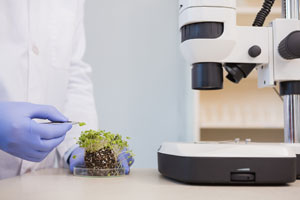Plants cannot testify, but they give up their secrets to forensic botanists who serve as expert witnesses. Forensic botanists help the police solve crimes. Then they help prosecutors or defense attorneys explain plant science to juries.
The Beginning of Forensic Botany
According to a recent article in Atlas Obscura, the first forensic botanist was Arthur Koehler. An authority on trees and wood who worked at the United States Forest Products Laboratory, Koehler got his start as an expert witness in cases involving wood that was used to construct homemade bombs and weapons.
Koehler went on to serve as the key witness in the 1935 trial of Bruno Hauptmann for kidnapping the baby of Charles and Anne Lindbergh. Based on a painstaking examination of a homemade ladder found outside the Lindbergh home, Koehler identified a mill in the Bronx as the source of the boards from which the ladder was made. Hauptmann had been employed at a lumber yard connected to the mill and had purchased wood stock that was consistent with the homemade ladder. Koehler provided the strongest evidence against Koehler when he testified that wood used to make a rail on the ladder exactly matched a board that had been removed from the attic in Hauptmann’s apartment. Without Koehler’s detailed analysis, Hauptman would probably not have been arrested, much less convicted.
It is interesting to read Koehler’s testimony, as well as defense counsel’s objection that Koehler’s study of wood “is not a science that has been recognized by the courts … this is merely a man who has had a lot of experience in examining trees.” Even in the modern Daubert era, “a lot of experience” coupled with a sound scientific analysis can provide the foundation for an expert opinion. The objection was overruled, as it would be today.
Forensic Botany Today
Modern forensic botanists are following Arthur Koehler’s example. The highly-publicized Casey Anthony murder trial featured a wide range of expert witnesses, including forensic pathologists, computer scientists, anthropologists, chemists, entomologists, and a forensic botanist. A key question in the case involved the length of time the 2-year-old victim’s body had been in the woods where it was discovered. The prosecution’s case depended on proof that the body had been there for at least a month. A botanist who examined the vegetation beneath the body testified that the body might only have been covering the vegetation for two weeks. Casey Anthony was acquitted of murder, manslaughter, and all other felony charges.
Two cases involving plant DNA illustrate how forensic botanists can help prosecutors convict the guilty while helping defense attorneys protect the innocent. In Arizona, the body of a hit-and-run victim was found near a group of paloverde trees. One of the trees had been damaged in the collision. A forensic botanist matched DNA from the damaged tree to seed pods found in the bed of a suspect’s car. The expert’s testimony cemented the hit-and-run conviction.
In Florida, a woman’s body was found in a shallow grave beneath an oak tree. Oak leaves were found in a suspect’s car. A forensic botanist compared DNA samples and determined that the leaves in the car could not have come from the tree at the grave site. That work saved the suspect from an unjust conviction.
Pollen and Spores
While DNA is often considered the gold standard in forensic science, pollen and spores (which easily stick to clothing) can also provide reliable evidence that links an individual to a crime scene. According to the Botanical Society of America, pollen and spores “are amazingly diverse.” A particular species may exist only in one specific location. Since they are microscopic, they act as “silent witnesses and even if they were visible, unlike fingerprints, they would be nearly impossible to eliminate from a crime scene.”
The Botanical Society of America laments the failure of most crime scene analysts to recognize the importance of forensic botanists in criminal investigations. While the FBI’s Handbook of Forensic Services discusses wood and cotton fibers, it does not address other kinds plant evidence. Crime scene investigators might notice leaves, but they do not routinely examine clothing for spores or other microscopic plant evidence that could help rule in or rule out criminal suspects. As forensic botanists continue to play an important role as expert witnesses, they may be able to educate police officers and attorneys about the kind of plant evidence that criminal investigations too often overlook.




